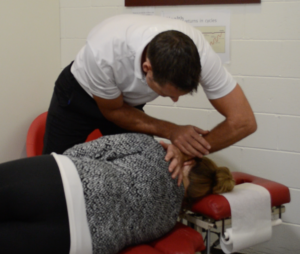Blair Upper Cervical Technique Explained
This interview with done by the Australian Spinal Research Foundation.
00:20
Thank You Oliver I was just finishing up
00:23
with chiropractic school and I realized
00:26
that I wanted to do something different
00:28
and we had had an introduction to toggle
00:30
recoil and early on in the curriculum
00:32
and there’s just something that
00:33
resonated with me about the upper
00:36
cervical approach it seemed to be very
00:39
scientific very very systematic in the
00:43
way that it was analyzing and looking at
00:45
what was actually going on I originally
00:47
was practicing the Atlas orthogonal but
00:50
after a few years in practice realized
00:52
that there were a few things that just
00:54
weren’t quite clearing the way that I
00:55
wanted to and had the good opportunity
00:58
to be introduced to Blair at a seminar
01:01
where I learned a few of the different
01:03
premises and realized wow this has got
01:07
some pretty amazing things that you know
01:09
even after a few years of practice I’ve
01:11
never seen or heard this before and
01:13
realized I gotta get into I’ve got to
01:15
get my hands on this and understand this
01:17
more because this is something profound
01:19
excellent can you tell me a little bit
01:21
about the development of play technique
01:23
where it came from that sort of thing
01:25
okay yep the Blair technique was founded
01:29
by Dr. William Blair, I believe
01:33
in 1950s graduate from Palmer College of
01:35
Chiropractic and had his life saved by a
01:39
toggle recoil adjustment. He had a very severe
01:42
automobile accident after he finished his
01:45
schooling he started doing the work
01:48
but had a patient particularly it was
01:50
his mother-in-law Dean who didn’t
01:52
respond very favorably to a certain
01:54
adjustment and you better believe that
01:56
that bothered him
01:58
dr. Blair was a very analytical person
02:00
and so he spent the next 10 to 20 years
02:03
then researching to understand certain
02:07
things about the way that the
02:09
biomechanics of the upper cervical spine
02:11
are and how they aren’t about certain
02:14
things that they thought were true at
02:15
the time actually weren’t and as a
02:18
result he developed some very unique
02:20
ways of analyzing what’s actually
02:23
happening in a person’s neck on a
02:25
person-to-person basis so that you’ve
02:27
got a crystal-clear view of what’s going
02:30
on and he worked to further Devolder
02:32
to further refine the standard
02:35
adjustment procedure that was being done
02:37
back at the time so I’ve had a little
02:40
bit of limited experience in that
02:41
Pacifico toxin they seem to be a very
02:43
precise group of people can you tell me
02:46
how Blair is different from the other
02:50
opposite we’ll take next nerve around
02:51
what sets them apart generally speaking
02:55
we’re more to the point what Blair is
02:57
Blair is the upper cervical specific and
03:01
articular approach and by that what I
03:05
mean is that many of the upper cervical
03:07
methods they identify and say
03:11
okay we’ve got a neutral model that
03:12
ideally we want to see a nice
03:14
up-and-down straight relationship an
03:17
orthogonal relationship between the
03:19
skull between the cervical spine and
03:21
that means that’s going to be the way
03:22
that the body’s going to be functioning
03:24
most appropriately and Blair in his
03:27
research in the way the technique
03:28
developed came to the realization that
03:31
that’s actually not so and so the major
03:34
difference is that we’re looking at a
03:36
person and a custom-tailored level so
03:40
their bone structure is different from
03:43
everybody else and it’s different on the
03:45
left side of the right side so we can’t
03:46
make side-by-side comparisons so what we
03:49
do is we do a very series of precise
03:52
measurements x-ray analysis and what
03:54
we’re able to do is we’re able to see
03:56
what’s going on in the inside of a
03:58
person and equal to identify this is
04:01
exactly what’s going on and therefore
04:04
this would be what the most precise type
04:07
of correction is that we can use with
04:09
the least amount of force that’s
04:10
necessary to be able to do that now for
04:15
my understanding you’ll be on the
04:17
advanced player instructor in Australia
04:19
yes yep so there’s not very many of you
04:22
guys can you tell me why it is that you
04:23
think that there’s not more of bleh in
04:26
Australia counteracting Wymore
04:28
chiropractors I’m practicing this – Matt
04:30
this technique I’d say a couple of
04:31
reasons – that first and foremost is the
04:33
vast majority of people have never heard
04:35
of it I don’t know how many dots in
04:38
Australia would be doing some form of a
04:40
straight talk or recoil but I do know
04:42
that among the seven or eight major
04:44
forms of upper cervical that there’s
04:46
maybe a total of about half a dozen
04:48
people doing that work a cervical
04:52
full-stop as their their go-to method
04:55
and then probably around a dozen or so
04:57
total doing any form of upper cervical
05:00
specific in its entirety I think in
05:03
large part it’s because they’ve never
05:05
heard of it or they have heard of it but
05:07
it’s never
05:08
something on offer even myself as you
05:11
can tell if my accent I’m not originally
05:13
from Australia for me to learn the type
05:16
of work that I love to do I had to
05:18
travel back and forth to the u.s. better
05:21
part of around ten times or so over
05:23
three to four years to get to where I am
05:26
at the moment most people that’s not
05:29
going to be something that they’re gonna
05:31
do and so the fact that we haven’t had
05:33
an accessible mmm makes it a bit of a
05:36
challenge but second to that if I was
05:39
going to say is it we’re gonna take a
05:41
very specific kind of person to be able
05:43
to do this kind of work even in the US
05:46
and North America and Canada and Europe
05:48
it’s only really about one to five
05:50
percent of the entire contracting
05:52
professionally doesn’t and I think it
05:54
requires that person who it’s not just
05:57
enough to say okay yep this is what
06:00
we’re gonna do they want to know the why
06:03
the what the how they want to know all
06:06
of the ins and out details of what’s
06:09
going on and and if this is them to a
06:12
fault
06:13
this is it is best is never good enough
06:16
you know they’re always what is that
06:18
next thing that next level that they’re
06:21
gonna take not just for their own
06:23
knowledge and general understanding but
06:24
so that they can make that best outcome
06:26
for that patient beautiful now there’s
06:30
very specific x-ray approach certainly
06:33
can you tell me a little bit about the
06:36
the
06:37
technique and equipment that you would
06:40
need in order to practice this in order
06:42
to get established as a player dock and
06:44
if you didn’t have access to that
06:45
technology and equipment then how would
06:47
you substitute that and how you sort of
06:49
make UI along okay bare-bones and this
06:52
was the the way that I started it myself
06:55
is having a table makes a really really
06:58
big difference so a proper side posture
07:00
with a drop piece headrest mechanism er
07:04
me in addition to that is having a
07:06
paraspinal thermal scanner because
07:09
that’s what we’re using is the
07:10
predominant way to measure what is the
07:12
neurological activity and the body to
07:14
make the decision does this patient need
07:17
the adjustment or not now beyond that
07:20
then yes the more precise we are in our
07:23
analysis of what’s going on in that
07:24
person in the first place the better
07:26
quicker we’re going to get that outcome
07:28
for them and so if we have access to
07:31
x-ray that’s a massive component because
07:35
really that’s the only way we’re seeing
07:37
what’s happening on the inside now if I
07:39
was starting out the work from scratch
07:41
again I would do it in that order I
07:43
would have my table scanner and then I
07:46
would get into x-ray ya know if I didn’t
07:50
have access to x-ray what I would do is
07:54
I would be done certain that I would be
07:55
referring for what’s called a cone beam
07:57
and CT so what that is if you’ve never
08:01
heard of that before is it’s this
08:03
scanner that was originally used by
08:05
dentist but what you’re seeing is you
08:07
can actually see what’s happening in the
08:09
cervical spine in 3d and it is just
08:13
beautiful resolution
08:15
is the future for all of this kind of
08:19
work and shows just some amazing detail
08:23
I mean this is phenomenal stuff if you
08:25
haven’t had the chance to look at him
08:27
now let’s say that I was doing a field
08:30
trip but I didn’t have access to my
08:31
imaging and I didn’t have image to my
08:33
scanner and I’m just having to rely on
08:36
my hands then I’m going to use backup by
08:38
using simply put what I can cross
08:40
correlating a few things with the
08:42
person’s posture with the person’s
08:45
basically you know doing certain kinds
08:47
of a leg checks posture checks muscle
08:50
tone muscle palpation but definitely
08:53
having the the instruments and to have
08:54
that insight into what’s going on in a
08:56
person goes such a long way excellent
09:00
now in terms of the technique how would
09:03
you describe the model of subluxation
09:05
that that Blair addresses and the how
09:08
you go about ascertaining the components
09:10
of that okay
09:13
generally speaking two parts so number
09:16
one is the the misalignment component so
09:18
we’re looking at the biomechanical
09:20
distortion that’s why we go to all the
09:23
effort to do the images that we do we’re
09:28
looking to see if the body is where
09:32
neutrally articulated as we would expect
09:34
it to be and I pathi size that okay if
09:37
it isn’t that’s a sign that something is
09:39
not right here and that’s where we’re
09:40
going to be focusing our attention but
09:43
what we’re also doing that is we’re
09:45
doing a series of neurological
09:46
assessments be it you know clinically
09:49
we’re looking at a person’s relative leg
09:51
length and changes in muscle tension
09:53
we’re looking at the pair of smile
09:56
patterns and we’re looking to see is
09:58
there evidence of adaptability or not on
10:01
those scans so all of that to determine
10:03
okay is this person’s body in a state of
10:07
physiological districts if the answer is
10:09
yes
10:09
maybe it’s an adjustment that they need
10:11
maybe not but if we can make it change
10:14
the adjusting okay that’s the
10:17
but as I was saying also that if that
10:19
person is based on the results of your
10:21
tests you know you’re doing pretty good
10:23
we’re not going to adjust you so that is
10:25
definitely one of the hallmarks about
10:27
what we’re doing is we’re realizing and
10:30
we’re looking at every single time a
10:32
person comes into our office they’re not
10:34
needing an adjustment so we have to take
10:36
a lot of care to determine what do they
10:39
need on any given day thank you for your
10:42
time
If you are interested in having a Blair Upper Cervical Assessment than make a booking with Dr. Andrew Timbs today.





